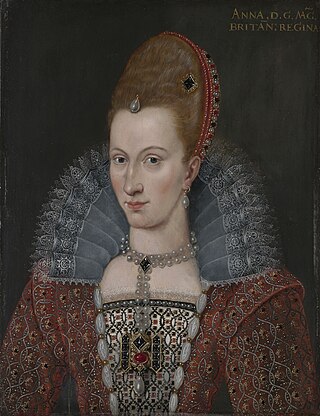
The North Berwick witch trials were the trials in 1590 of a number of people from East Lothian, Scotland, accused of witchcraft in the St Andrew's Auld Kirk in North Berwick on Halloween night. They ran for two years, and implicated over 70 people. These included Francis Stewart, 5th Earl of Bothwell, on charges of high treason.

Christoffer Valkendorff was a Danish-Norwegian statesman and landowner. His early years in the service of Frederick II brought him both to Norway, Ösel and Livland. He later served both as Treasurer and Stadtholder of Copenhagen and finally as Steward of the Realm from 1596 to 1601. He owned Glorup Manor on Funen from 1535 to 1601, whose current main building he constructed, although it has later been adapted in the Neoclassical style. He constructed the old Town Hall in Bergen, and he also constructed Svindinge Church, on Funen, one of the best preserved Renaissance style churches in Denmark. He founded the dormitory Valkendorfs Kollegium in Copenhagen where the street Valkendorfsgade is named after him.

The Torsåker witch trials took place in 1675 in Torsåker parish in Sweden and were the largest witch trials in Swedish history. In a single day 71 people were beheaded and then burned.

Agnes Sampson was a Scottish healer and purported witch. Also known as the "Wise Wife of Keith", Sampson was involved in the North Berwick witch trials in the later part of the sixteenth century.
Brita, "the wife of Jöran Pipare" was an alleged Swedish witch. Her case is a significant one, illustrating a witch trial held when the belief in witchcraft had increased, but the law still did not permit harsh persecution of magic practice.
Geske, also known as Horgeske was the central figure of a witch trial in Stockholm. Her trial belonged to the first of the witch trials in Sweden in which the Sabbath of Satan in Blockula, the Devils pact and the Devil's mark were mentioned.
Hans Pauli was a Swedish Bridgettine monk and an alleged sorcerer, active as a professional exorcist and counter-magician.
Ane Koldings was an alleged Danish witch. She was a main defendant in the Copenhagen witch trials held during the summer of 1590, which were held as a parallel to the famous North Berwick Witch trials in Edinburgh in Scotland.
Christence (Christenze) Akselsdatter Kruckow was a Danish noblewoman who was executed for witchcraft after having been accused twice. She is one of the most well known victims of the witch hunt in Denmark, and one of few members of the nobility to have been executed for sorcery in Scandinavia, and the only one in Denmark.

Niels Hemmingsen, Latinized Nicolaus Hemmingius, was a Danish Lutheran theologian. He was pastor of the Church of the Holy Ghost, Copenhagen and professor at the University of Copenhagen. The street Niels Hemmingsens Gade in Copenhagen is named in his honor.

The Witch Trials of Trier took place in the independent Catholic diocese of Trier in the Holy Roman Empire in present day Germany between 1581 and 1593, and were perhaps the largest documented witch trial in history in view of the executions. They formed one of the four largest witch trials in Germany alongside the Fulda witch trials, the Würzburg witch trial, and the Bamberg witch trials.

Anne Palles was an alleged Danish witch. She was the last woman to be legally executed for sorcery in Denmark.
Events from the year 1722 in Denmark.
Johan Pistorius, was a Danish grenadier. He was judged guilty of making a Satanic pact, and was the last person executed for witchcraft in Denmark.
Louise Nyholm Kallestrup is a Danish historian. She is a professor at the University of Southern Denmark (Odense) and the director of its Centre for Medieval and Renaissance Studies who specializes in the Early Modern Period. Best known for her comparative research on witchcraft trials in Denmark and Italy. Kallestrup has also written widely on such related topics as gender in the contexts of legal proceedings and urbanization, and on demonology and is a frequent cultural commentator in the Danish press and on radio.

Peder Munk of Estvadgård (1534–1623), was a Danish navigator, politician, and ambassador, who was in charge of the fleet carrying Anne of Denmark to Scotland. The events of the voyage led to witch trials and executions in Denmark and Scotland.

The Witch trials in Denmark are poorly documented, with the exception of the region of Jylland in the 1609–1687 period. The most intense period in the Danish witchcraft persecutions was the great witch hunt of 1617–1625, when most executions took place, which was affected by a new witchcraft act introduced in 1617.
Gyldenstierne-sagen was a witch trial which took place in Denmark between 1596 and 1598. Alongside the Nakkebølle-sagen, it was one of two big witchcraft cases in the 1590s which was essentially caused by feuds among the Danish noble families.
Karen Roeds, was a Danish woman who was executed for witchcraft. She was one of the victims of the great Danish witch hunt of 1617–1625, and a typical example of those accused; almost all of the characteristics of her trial were typical of the trials during the witch hunt of 1617-1625.

Anne of Denmark (1574–1619) was the queen of Scotland from her marriage by proxy to King James VI on 20 August 1589 and queen of England and Ireland from his accession on 24 March 1603 until her death in 1619. When Anne intended to sail to Scotland in 1589 her ship was delayed by adverse weather. Contemporary superstition blamed the delays to her voyage and other misfortunes on "contrary winds" summoned by witchcraft. There were witchcraft trials in Denmark and in Scotland. The King's kinsman, Francis Stewart, 5th Earl of Bothwell came into suspicion. The Chancellor of Scotland John Maitland of Thirlestane, thought to be Bothwell's enemy, was lampooned in a poem Rob Stene's Dream, and Anne of Denmark made Maitland her enemy. Historians continue to investigate these events.








